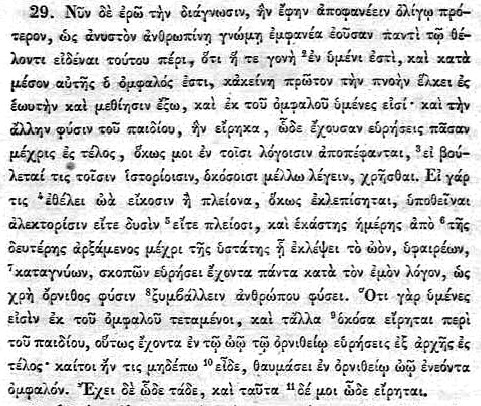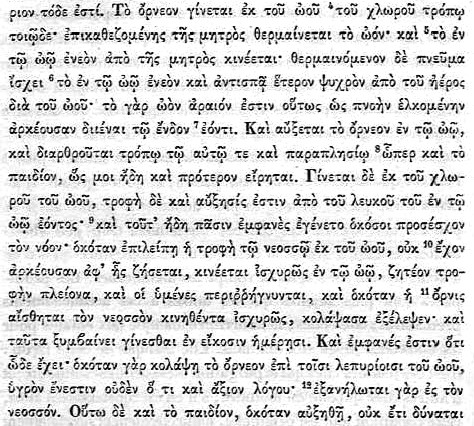Hippochick
The chick of Hippocrates
Corpus
Hippocraticum
De natura pueri - On the nature of the infant
According
to Galen the treatise has to be attributed to Polybus
pupil and son-in-law of Hippocrates
Greek
text from
Oeuvres complètes d'Hippocrate - volume 7
Émile Littré – Paris 1851
Translated
by Roberto Ricciardi
September 11th 2010
|
|
§ 29. I will now report the observation just now I said I would have express, and, as far as it is possible to human intelligence, it is evident, to whoever wants to examine these things, that the seed is in the membrane, and that in its center there is the navel, and that the former firstly attracts the breath on itself and sends it outside, and that from the navel the membranes are departing; and if someone wants to use as proofs of what I am about to say, you will find that the remaining structure of the child, about whom I have spoken, is wholly so composed until the end, as by me it has been shown in my expositions. In fact if someone wants to put under two or more hens 20 or more eggs so that they hatch, every day, starting from the second until the last day when the egg will hatch, taking it, breaking it, examining it, he will find that it has every requirement according with my opinion, according to which we have to compare the nature of the bird with that of the man. In fact the membranes stretch from the navel, and you will find that the other things said about the child appear from start to finish in the egg of bird; but if someone has not observed in depth, he will be surprised that there is a navel in the egg of bird. This way the things are, and these things have been said by me this way. |
|
|
§ 30. [...] The bird is born from the yellow of the egg in such way: the egg gets warm since the mother broods it; and the matter residing in the egg is moved by the mother; and the substance in the egg, by getting warm, gets a breath and in turn attracts another cold one coming from the air through the egg; in fact the egg is so rarefied that the transpiration so attracted penetrates in sufficient degree in the inner part. And the bird grows in the egg and provides itself with joints in a same and similar way of the child, as by me also previously it has been said. It is born from the yellow of the egg, but the nourishment and the growth come from the white present in the egg; and by now what follows became manifest to all those people who paid attention: each time the chick misses the nourishment coming from the egg, then, not having enough nourishment with which it can live, it stirs violently in the egg, having to look for more food, and the membranes break around, and each time the hen realizes that the chick has stirred with violence, having lacerated the shell with the beak she does it to hatch; and these things happen in 20 days. And it is clear that the things are this way: in fact each time the hen digs the shells of the egg by blows of beak, there is nothing of liquid worthy of mention; in fact it has been consumed for the chick. [...] |

